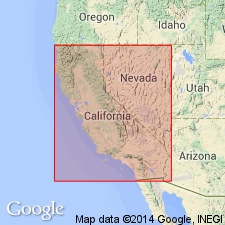
- Usage in publication:
-
- Contra Costa group
- Modifications:
-
- Original reference
- AAPG geologic province:
-
- Northern Coast Range province
- Sacramento basin
Summary:
Pg. 6 (fig. 3), 14-15. Lawson (1914) mapped and described continental deposits within Las Trampas Ridge area as Orinda formation (Las Trampas Ridge 7.5-min quadrangle, Alameda and Contra Costa Cos., western CA). Lawson and Palache (1902) designated lower Pliocene silt, sandstone, and conglomerate in Berkeley Hills as type Orinda. Subsequent work to the east by D.E. Savage and others [abs.], 1951 (GSA Cordilleran Sec. Mtg., Los Angeles, GSA Bull., v. 62, no. 12, pt. 2, p. 1511) has shown need for revision of terminology. Term Contra Costa group is suggested to include five formations, the Orinda being at base. [On p. 15 author states Savage and others suggested the term Contra Costa be revived for a group; they do not mention Contra Costa in their abstract.] Within Las Trampas Ridge area only two of the five formations, Orinda and Mulholland, are recognized, the Grizzly Peak, Siesta, and Bald Peak formations being absent. Overlies San Pablo group. Age is late Miocene to middle Pliocene.
[Type locality not stated.]
Source: Publication; US geologic names lexicon (USGS Bull. 1200, p. 922).
For more information, please contact Nancy Stamm, Geologic Names Committee Secretary.
Asterisk (*) indicates published by U.S. Geological Survey authors.
"No current usage" (†) implies that a name has been abandoned or has fallen into disuse. Former usage and, if known, replacement name given in parentheses ( ).
Slash (/) indicates name conflicts with nomenclatural guidelines (CSN, 1933; ACSN, 1961, 1970; NACSN, 1983, 2005, 2021). May be explained within brackets ([ ]).

